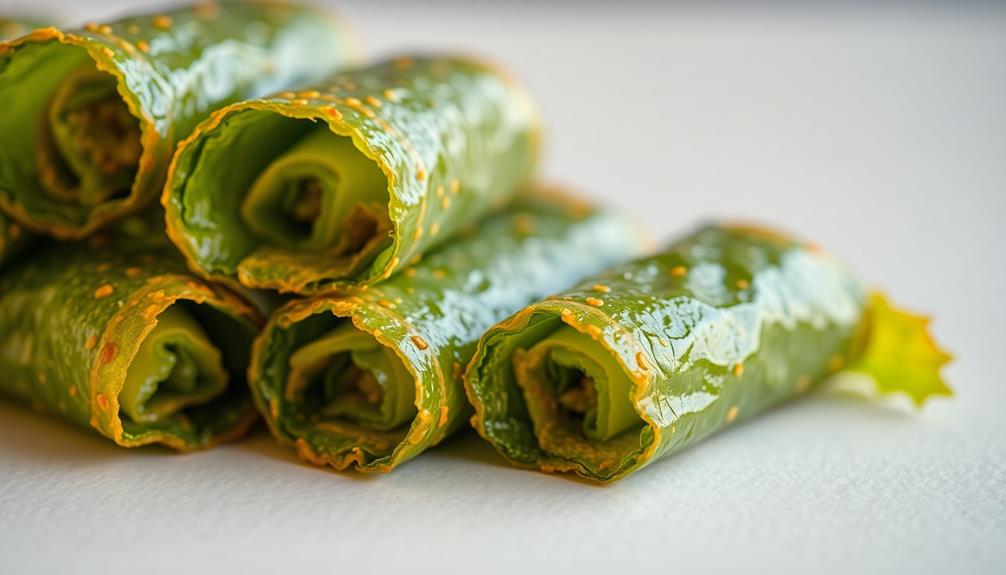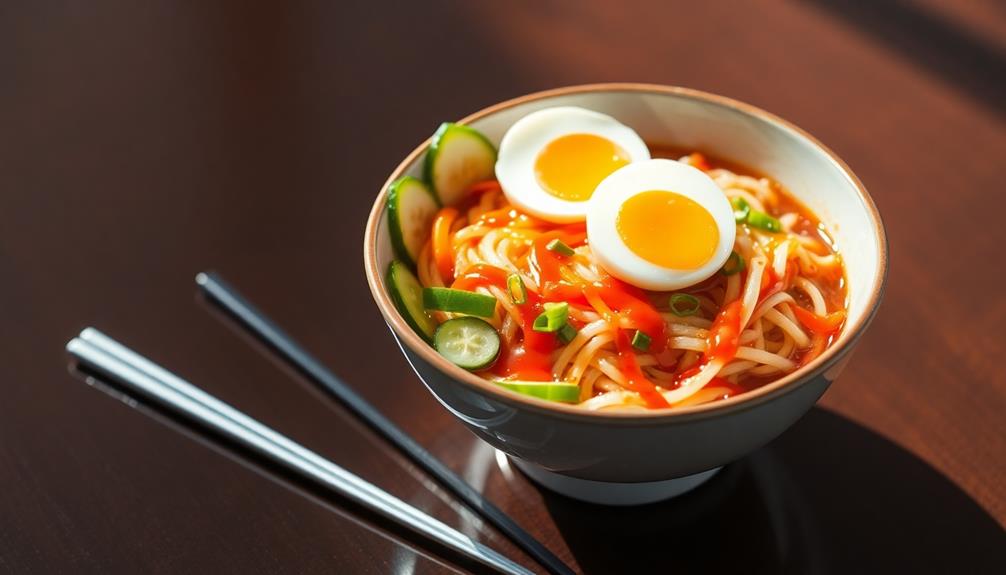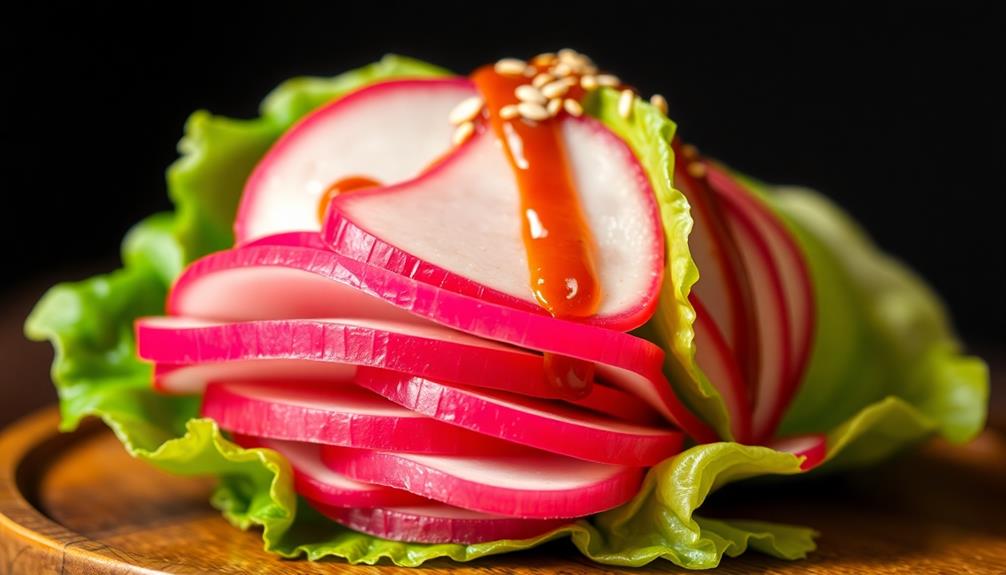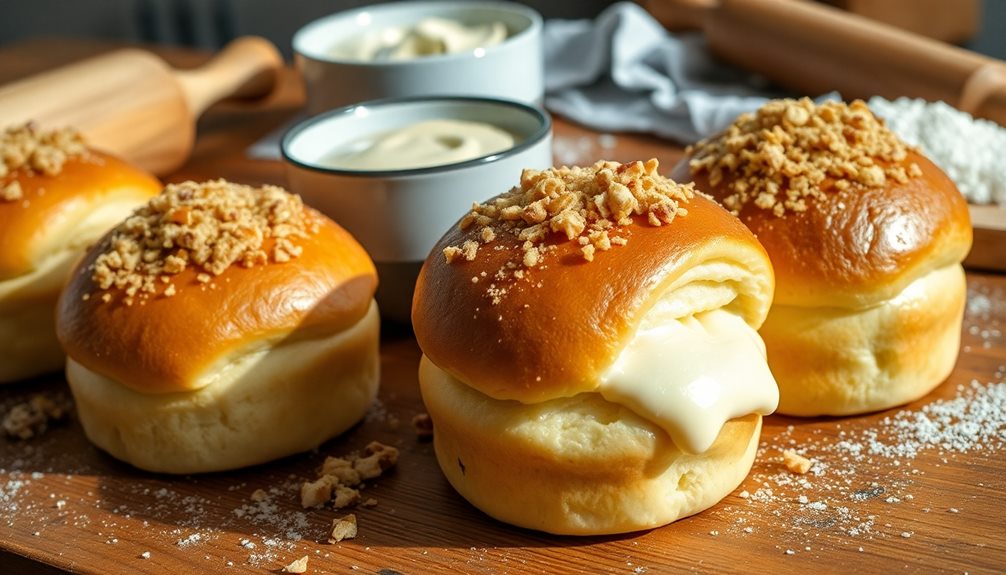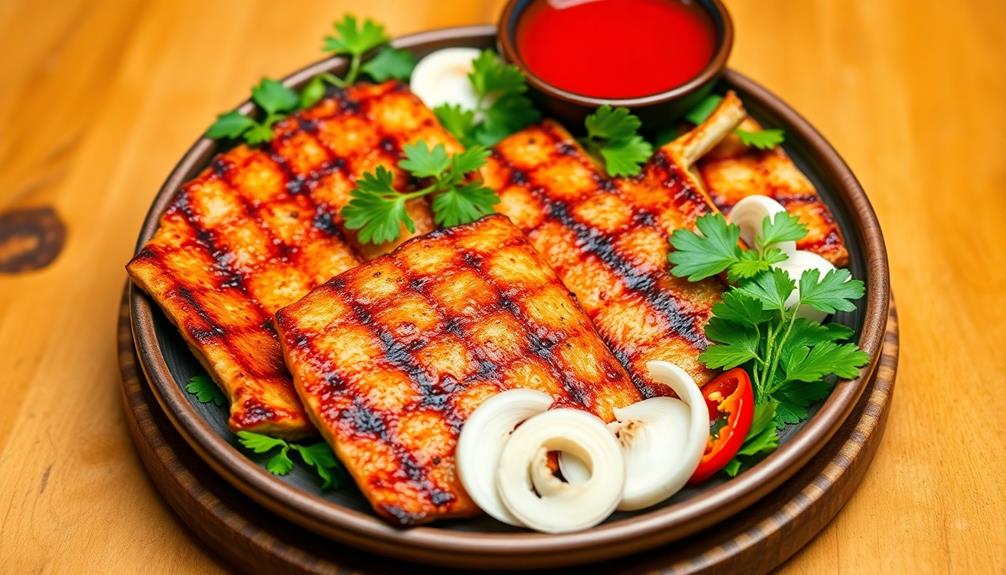Seaweed rolls, also known as gimbap in Korea, are a delicious and healthy snack you'll love! These crispy treats combine the crunch of nori sheets with fresh, flavorful fillings like veggies, protein, and sauces. They're easy to make at home – just soak the seaweed, spread on rice, add your favorite toppings, and roll it up. Seaweed rolls are packed with vitamins, minerals, and fiber, making them a guilt-free snack. Plus, they're super versatile, perfect for parties, picnics, or a quick bite. You'll be rolling up these Korean favorites in no time – let's dive into the full recipe and step-by-step instructions!
Key Takeaways
- Seaweed rolls, known as gimbap in Korea, are a versatile and nutritious snack featuring crisp nori sheets, sushi rice, and diverse fillings.
- To make seaweed rolls, soak nori sheets, spread rice, add fillings, and roll tightly, ensuring a secure wrap for optimal texture and flavor.
- Experiment with a variety of fillings, including fresh vegetables, proteins, and sauces, to create unique and customizable seaweed roll combinations.
- Slice the rolls diagonally with a sharp, wet knife for a clean presentation, and serve immediately with dipping sauces for the best experience.
- Seaweed rolls are a popular social food, suitable for gatherings, parties, and family celebrations, offering a communal dining experience with their crisp texture and savory flavors.
History
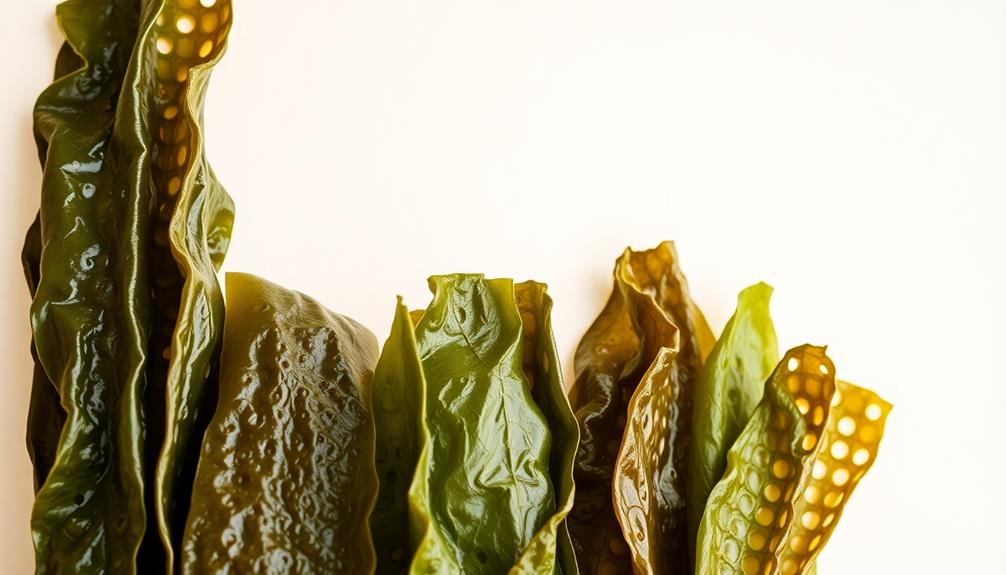
Thought to have originated in ancient China, seaweed rolls have long been a staple in Asian cuisine.
These crunchy, savory treats have a fascinating history that spans centuries and cultures. Traditionally, seaweed rolls were made using simple ingredients like dried seaweed, rice, and vegetables.
Over time, the recipe evolved, with creative chefs adding their own unique twists.
In Korea, seaweed rolls became particularly popular, known as gimbap.
These colorful rolls often feature a variety of fillings, from spicy tuna to pickled radish. They're a beloved snack for families and friends, perfect for picnics, parties, or just a quick, satisfying bite.
Today, seaweed rolls can be found in Asian markets and restaurants around the world, shared and enjoyed by people of all ages.
Whether you're new to the world of seaweed rolls or a seasoned fan, their rich history and delicious flavors are sure to delight your taste buds.
Recipe
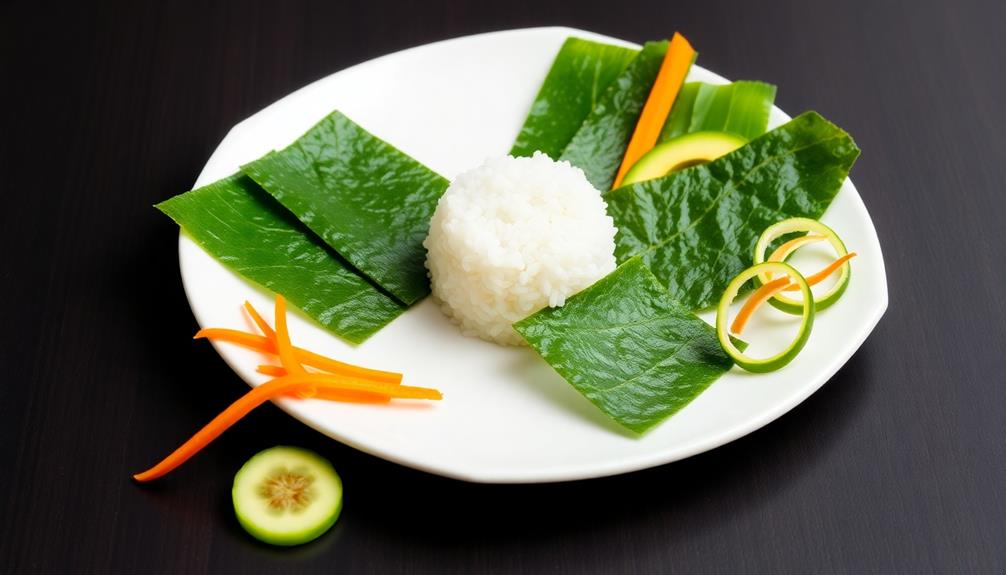
Seaweed rolls are a delightful, nutritious, and versatile dish that can be enjoyed as an appetizer, snack, or even a light meal. The combination of crisp nori sheets, fragrant sushi rice, and fresh, flavorful fillings creates a harmonious blend of textures and tastes.
The process of making seaweed rolls, also known as sushi rolls or maki, may seem daunting at first, but with a little practice, it becomes a rewarding and satisfying culinary experience. The joy of crafting these delicate rolls lies not only in the final product but also in the act of creating something visually appealing and pleasing to the palate.
Ingredients:
- 2 cups sushi rice
- 4 sheets of nori (seaweed sheets)
- 1 avocado, sliced
- 1 cucumber, julienned
- 1 carrot, julienned
- 4 oz cooked crab meat or imitation crab
- Soy sauce, for serving
Cooking Instructions:
Cook the sushi rice according to package instructions. Allow it to cool slightly, then spread it evenly on a baking sheet or large plate.
Place a nori sheet shiny-side down on a bamboo sushi mat. Wet your hands and spread a thin layer of rice over the nori, leaving a 1-inch border at the top. Arrange your desired fillings in a line across the center of the rice.
Using the sushi mat, carefully roll the nori tightly around the fillings, pressing gently to secure the roll. Slice the rolled sushi into 6-8 pieces and serve with soy sauce.
Tips:
For best results, use a sharp knife and wet it before slicing the rolls to prevent the rice from sticking.
Additionally, consider experimenting with different fillings, such as thinly sliced cucumber, avocado, cooked shrimp, or even spicy tuna, to create your own unique seaweed roll variations.
Enjoy your homemade seaweed rolls with family and friends, and savor the flavors of this delightful Japanese-inspired dish.
Cooking Steps
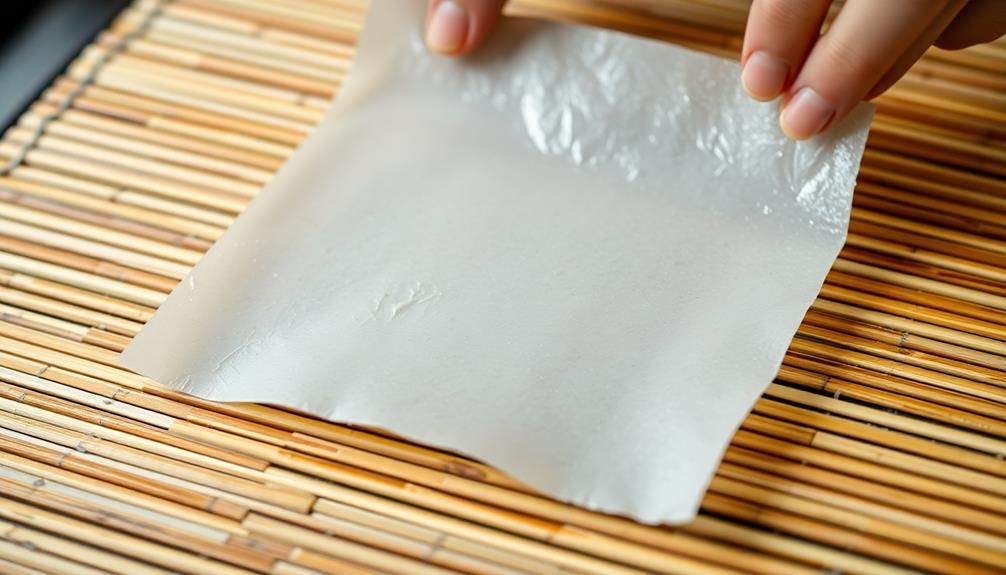
Soak the seaweed sheets in water until pliable, then spread the rice mixture evenly across the surface.
Carefully roll the seaweed sheets tightly, and cut the rolls diagonally for a beautiful presentation.
Serve immediately with your desired dipping sauce and enjoy this delightful, homemade treat!
Step 1. Soak Seaweed Sheets in Water
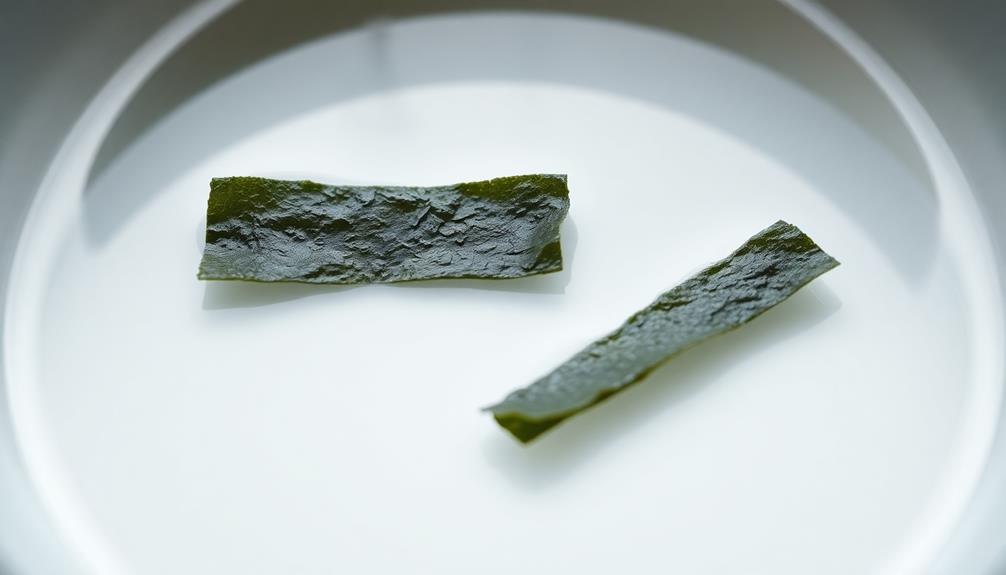
To begin, soak the seaweed sheets in water for a few minutes. This helps them become soft and pliable, making them easier to work with when rolling up your delicious seaweed rolls.
Submerge the sheets completely and let them sit until they've softened, about 3-5 minutes. Gently pat the sheets dry with a clean towel or paper towels. Be careful not to tear them!
Once they're ready, you can start assembling your rolls. Lay a softened sheet flat on your work surface. Add your favorite fillings, like seasoned rice, crunchy veggies, or savory meats.
Carefully roll up the sheet, tucking in the sides as you go. Secure the roll with a toothpick or small piece of nori. Repeat with the remaining sheets and fillings.
Now your seaweed rolls are ready to be enjoyed! Crispy on the outside and bursting with flavor on the inside – a true Korean delight.
Step 2. Spread Rice Mixture Evenly
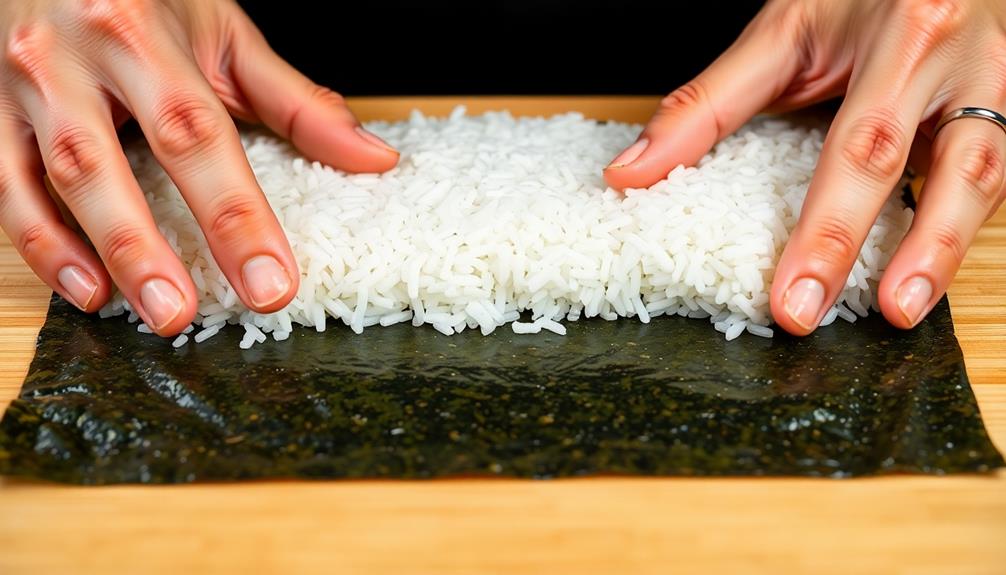
Once the seaweed sheets have softened, it's time to spread the rice mixture evenly across them. You'll want to use a spoon or your hands to gently distribute the rice, making sure it covers the entire surface.
Don't be afraid to get a little messy – this is all part of the fun! Spread the rice in a thin, even layer, leaving a small border around the edges. This will help the rolls hold their shape when you start to roll them up.
Next, you'll need to carefully flip the seaweed sheet over so the rice is facing down. This will allow you to roll the sheet tightly, with the rice on the inside.
Start at one end and gently roll the sheet up, using your fingers to guide the rice as you go. Take your time and be gentle – you don't want the rice to spill out. Once you've reached the other end, give the roll a gentle squeeze to help it hold its shape.
Step 3. Roll Seaweed Sheets Tightly
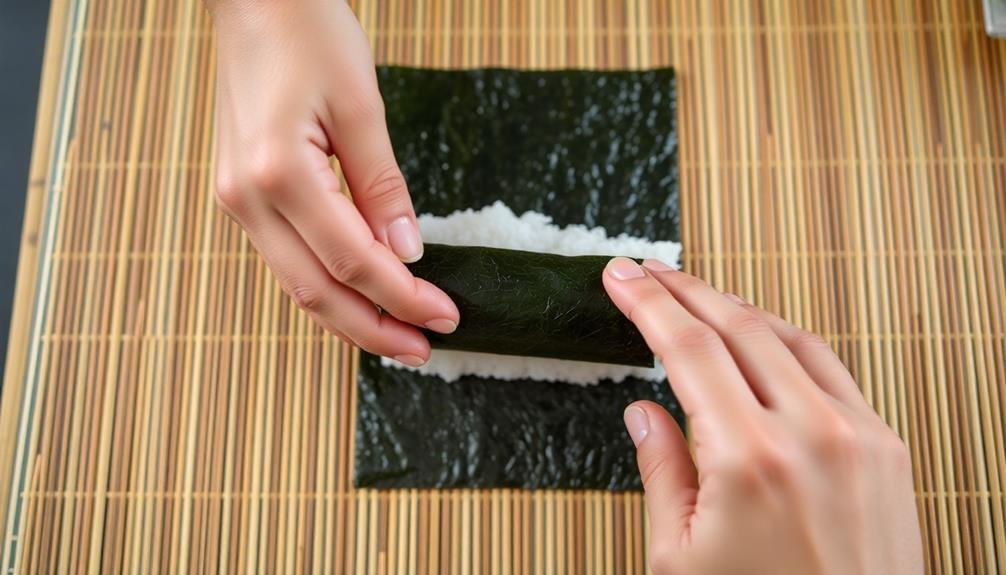
With the rice evenly spread, it's time to roll the seaweed sheets tightly.
Grab a sheet of seaweed and place it on a clean, flat surface. Gently spread a thin layer of the rice mixture over the entire surface, leaving a small border at the top.
Now, starting from the bottom, slowly roll the seaweed sheet up tightly, using your fingers to keep the roll compact. As you roll, be careful not to squeeze too hard, or the seaweed may tear. Keep rolling until you reach the top, creating a neat, cylindrical roll.
Repeat this process with each seaweed sheet, ensuring they're all rolled tightly. This will help the rolls maintain their shape and crunchy texture.
Once you've rolled all the sheets, use a sharp knife to slice each roll into bite-sized pieces, about 1-inch thick. Serve the seaweed rolls immediately, or store them in an airtight container for up to 3 days.
Enjoy these crispy, flavorful Korean delights!
Step 4. Cut Rolls Diagonally
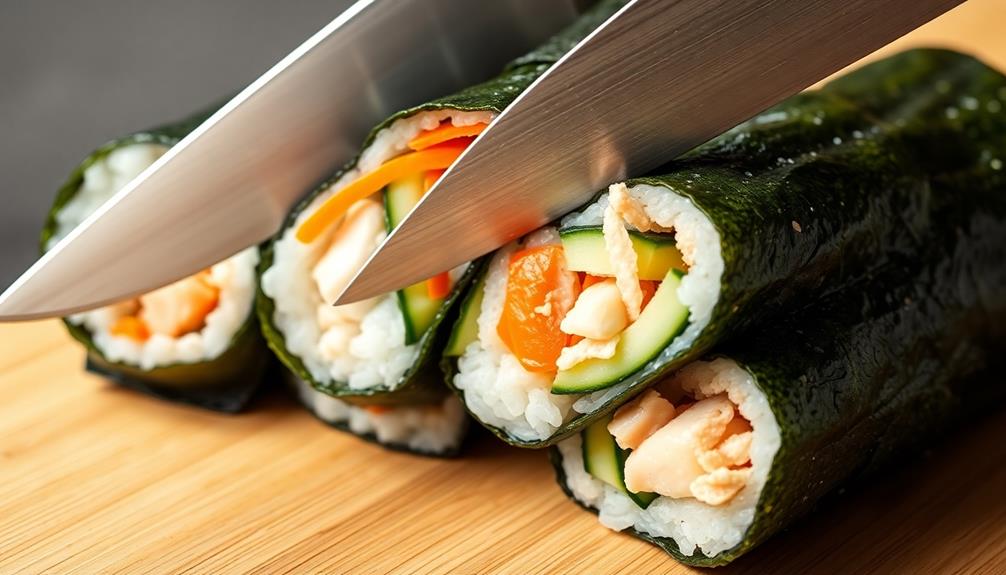
After rolling the seaweed sheets tightly, you'll want to slice each roll diagonally. This will create beautiful, bite-sized pieces that are perfect for sharing with friends and family.
Use a sharp knife to make clean, even cuts, slicing the rolls at a 45-degree angle. You'll end up with a plate of colorful, crescent-shaped seaweed rolls that are just begging to be dipped in your favorite sauces.
The diagonal cut not only makes the rolls look extra fancy, but it also helps them bite-sized and easy to eat. Pop one in your mouth and enjoy the crunchy texture and savory flavor of the seaweed, all wrapped up in a delightful little package.
Your guests are sure to be impressed by your knife skills and the stunning presentation. So, don't be afraid to get a little creative with your cuts – the more diagonal, the better!
Step 5. Serve Immediately With Desired Dipping Sauce
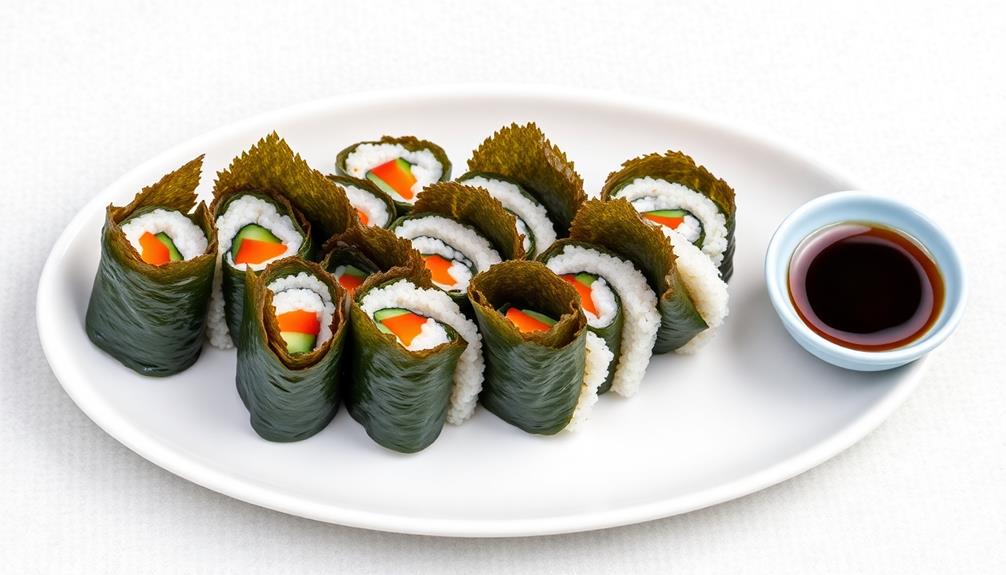
Serve the diagonally-cut seaweed rolls immediately, accompanied by your favorite dipping sauce.
These crispy Korean treats are best enjoyed fresh, with the warm, savory flavors bursting in your mouth. Don't wait – dive right in! Pair them with your favorite dipping sauce or a side of vibrant pickled vegetables for an extra punch of flavor. For those looking to get a bit creative in the kitchen, try incorporating them into a unique kimchi quesadilla fusion recipe that combines bold Korean spices with cheesy, gooey comfort. It’s a perfect way to reinvent these treats while keeping all the delicious excitement intact!
For a classic pairing, try a tangy soy sauce dip.
Simply mix soy sauce, rice vinegar, a touch of sesame oil, and a sprinkle of chopped green onions. The salty-sweet combination will perfectly complement the nori wraps.
Or, for a bolder flavor, whip up a spicy gochujang sauce.
Combine gochujang (Korean chili paste), honey, garlic, and a splash of water to create a thick, flavorful dip. The heat from the gochujang will make your taste buds tingle.
Regardless of your dipping sauce preference, serve the seaweed rolls right away, while they're still warm and crunchy.
Dip, savor, and enjoy these delightful Korean delicacies with family and friends!
Final Thoughts
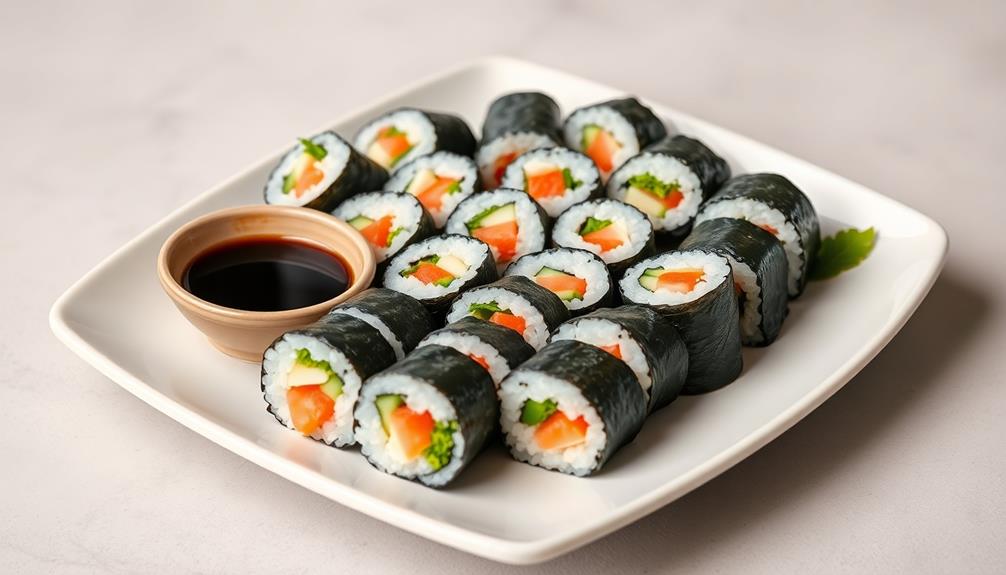
Seaweed rolls make for a delightful and nutritious snack. Not only are they packed with flavor, but they're also a great way to incorporate more wholesome ingredients into your diet.
The crispy texture and savory taste of the seaweed wrapper create a truly satisfying experience.
What's even better? Seaweed rolls are incredibly versatile. You can customize them with your favorite fillings, from fresh vegetables to delicious proteins.
Plus, they're perfect for sharing with friends and family, making them an excellent choice for gatherings and celebrations.
Frequently Asked Questions
How Long Do Seaweed Rolls Last in the Fridge?
Seaweed rolls can last up to a week in the fridge when stored properly in an airtight container. For best quality and crispness, it's best to consume them within 3-4 days of making them.
Can I Use Different Types of Seaweed for This Recipe?
Absolutely, you can use different types of seaweed for this recipe. Feel free to experiment with nori, kombu, or even wakame to create your own unique spin on these crispy Korean favorites.
What Is the Best Way to Store Leftover Seaweed Rolls?
To store leftover seaweed rolls, place them in an airtight container or resealable bag. They'll keep in the fridge for 3-4 days. Just reheat in the oven or air fryer before serving to restore their crispiness.
Can I Freeze Seaweed Rolls for Later Use?
Yes, you can freeze seaweed rolls for later use. Allow them to cool completely, then wrap them individually in plastic wrap or foil. Place the wrapped rolls in an airtight container or freezer bag and freeze for up to 3 months.
How Do I Make the Rolls Extra Crispy?
To make the rolls extra crispy, you should first ensure the seaweed is completely dry before assembling. Next, fry the rolls in hot oil until golden brown, and don't be afraid to let them sizzle for a bit.
